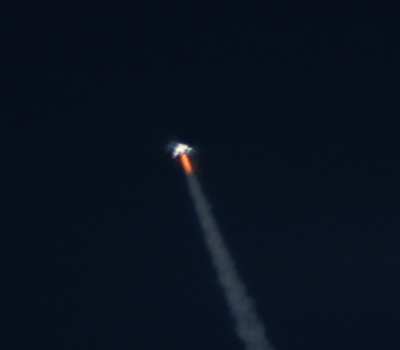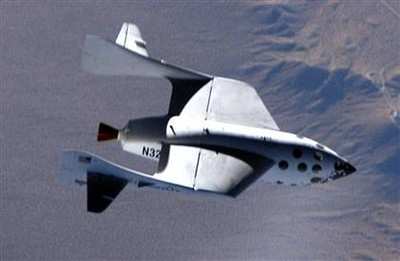Wed, May 19, 2004
Third Powered Flight Sets New Records
SpaceDev's hybrid rocket motor technology successfully propelled
SpaceShipOne on its third, and record-breaking, manned flight on
May 13, 2004. SpaceShipOne accelerated to record setting altitudes
and speed, both higher than in previous powered flights, thus
bringing the Scaled Composites team a step closer to winning the
$10 million Ansari X-Prize.

The White Knight carrier released SpaceShipOne at 46,000 feet,
and SpaceDev's hybrid rocket motor was ignited 10 seconds after
release and burned for the full planned 55 seconds. The rocket
ship, with pilot Mike Melvill at the controls, achieved a speed of
Mach 2.5 and climbed to 211,400 feet, over 40 miles above the
Earth, and 106,400 feet further toward space than the previous
record of 105,000 feet. NASA and the Air Force award astronaut
wings at 50 miles.
SpaceShipOne's first powered flight took place on December 17,
2003, with SpaceDev's hybrid motor firing for 15 seconds. A second
powered flight occurred on April 8th of this year. In that mission,
the motor burned for 40 seconds. Scaled Composites spokesperson
Kaye LeFebvre told TechNewsWorld that Scaled next plans to push a
test flight higher to the 100-kilometer mark, or about 62.5 miles.
"With today's flight, much of the major technical challenges have
been overcome. It's just a matter of going higher with more
people," said Scaled Composites founder Burt Rutan. LeFebvre said
that Scaled would work to add additional occupants to the craft to
meet the X-Prize requirement for three travelers.

"This most recent SpaceShipOne flight, powered by SpaceDev's
hybrid rocket propulsion system, flying higher and faster than
before, is like a dream made to come true through the imagination
and skill of the SpaceDev and Scaled engineers," said Benson.
"These flights are helping SpaceDev realize our mission of moving
space flight to the private sector and opening it to the general
public. Some surveys and analysts project the possibility of a
multibillion commercial space tourism business, and SpaceDev
intends to participate in that market to the fullest extent
possible. These successful, private sector rocket-powered human
flights demonstrate that the commercial sector can supply safe and
affordable human space flight. As a company, all of us here are
excited that SpaceDev is helping make space happen for all of
humanity," added Benson.
More News
Scheduled for Friday, November 7th at 1800ET, The MOSAIC Town Hall, Webcast At www.airborne-live.net One of the more intriguing features of the 2025 Affordable Flying Expo, schedul>[...]
From 2023 (YouTube Edition): The Mosquito Evolves Formerly known as Mosquito, Trenton, Florida-based Composite FX is a designer and manufacturer of personal kit and factory-finishe>[...]
“The Board is pleased to name Lisa as our next CEO after conducting a comprehensive succession planning process and believes this transition will ensure continued success for>[...]
Ground Stop (GS) The GS is a process that requires aircraft that meet a specific criteria to remain on the ground. The criteria may be airport specific, airspace specific, or equip>[...]
The Airplane Stalled Above The Runway Threshold, The Nose Dropped, The Nose Wheel Impacted The Runway, And The Airplane Flipped Over Analysis: The pilot reported that during the fi>[...]
 Affordable Flying Expo Announces Industry MOSAIC Town Hall
Affordable Flying Expo Announces Industry MOSAIC Town Hall Classic Aero-TV: Composite-FX Sets Elevates the Personal Helicopter Market
Classic Aero-TV: Composite-FX Sets Elevates the Personal Helicopter Market Aero-News: Quote of the Day (10.25.25)
Aero-News: Quote of the Day (10.25.25) ANN's Daily Aero-Term (10.25.25): Ground Stop (GS)
ANN's Daily Aero-Term (10.25.25): Ground Stop (GS) NTSB Final Report: Gallow Daniel A Kitfox Classic IV
NTSB Final Report: Gallow Daniel A Kitfox Classic IV




